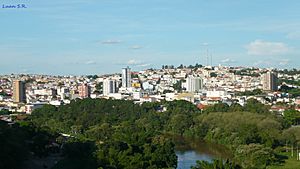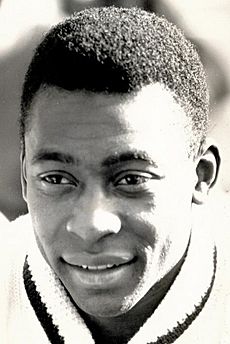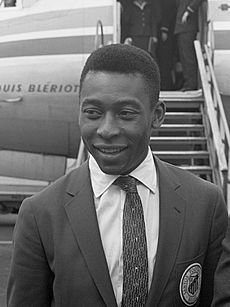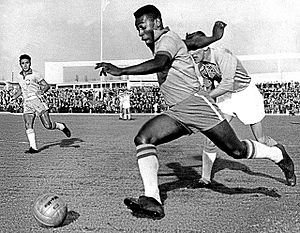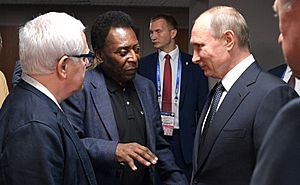Pelé facts for kids
Quick facts for kids
Pelé
|
||||||||||||||||||||||||||||||||||||||||||||||||||||||||||||||||||||||||||
|---|---|---|---|---|---|---|---|---|---|---|---|---|---|---|---|---|---|---|---|---|---|---|---|---|---|---|---|---|---|---|---|---|---|---|---|---|---|---|---|---|---|---|---|---|---|---|---|---|---|---|---|---|---|---|---|---|---|---|---|---|---|---|---|---|---|---|---|---|---|---|---|---|---|---|
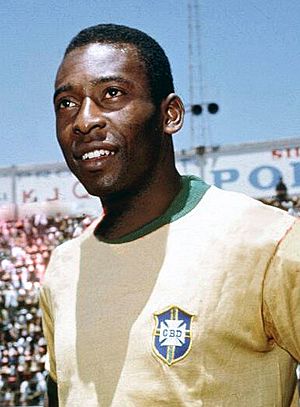
Pelé with Brazil in 1970
|
||||||||||||||||||||||||||||||||||||||||||||||||||||||||||||||||||||||||||
| Born |
Edson Arantes do Nascimento
23 October 1940 Três Corações, Brazil
|
|||||||||||||||||||||||||||||||||||||||||||||||||||||||||||||||||||||||||
| Died | 29 December 2022 (aged 82) São Paulo, Brazil
|
|||||||||||||||||||||||||||||||||||||||||||||||||||||||||||||||||||||||||
| Resting place | Memorial Necrópole Ecumênica, Santos, São Paulo | |||||||||||||||||||||||||||||||||||||||||||||||||||||||||||||||||||||||||
| Occupation |
|
|||||||||||||||||||||||||||||||||||||||||||||||||||||||||||||||||||||||||
| Height | 1.73 m (5 ft 8 in) | |||||||||||||||||||||||||||||||||||||||||||||||||||||||||||||||||||||||||
| Spouse(s) |
Rosemeri dos Reis Cholbi
(m. 1966; div. 1982)Assíria Lemos Seixas
(m. 1994; div. 2008)Marcia Aoki
(m. 2016) |
|||||||||||||||||||||||||||||||||||||||||||||||||||||||||||||||||||||||||
| Children | 7, including Edinho and Joshua Nascimento | |||||||||||||||||||||||||||||||||||||||||||||||||||||||||||||||||||||||||
| Parent(s) |
|
|||||||||||||||||||||||||||||||||||||||||||||||||||||||||||||||||||||||||
| Relatives | Zoca (brother) | |||||||||||||||||||||||||||||||||||||||||||||||||||||||||||||||||||||||||
|
Association football career
|
||||||||||||||||||||||||||||||||||||||||||||||||||||||||||||||||||||||||||
| 1st Minister of Sports | ||||||||||||||||||||||||||||||||||||||||||||||||||||||||||||||||||||||||||
| In office 1 January 1995 – 30 April 1998 |
||||||||||||||||||||||||||||||||||||||||||||||||||||||||||||||||||||||||||
| President | Fernando Henrique Cardoso | |||||||||||||||||||||||||||||||||||||||||||||||||||||||||||||||||||||||||
| Preceded by | Office established | |||||||||||||||||||||||||||||||||||||||||||||||||||||||||||||||||||||||||
| Succeeded by | Rafael Greca (Sports and Tourism) | |||||||||||||||||||||||||||||||||||||||||||||||||||||||||||||||||||||||||
| Signature | ||||||||||||||||||||||||||||||||||||||||||||||||||||||||||||||||||||||||||
 |
||||||||||||||||||||||||||||||||||||||||||||||||||||||||||||||||||||||||||
Edson Arantes do Nascimento (born 23 October 1940 – died 29 December 2022), known as Pelé, was a Brazilian professional footballer. He played as a forward.
Many people think Pelé was one of the greatest football players ever. FIFA even called him "the greatest". He was very successful and popular in sports during the 20th century. In 1999, the International Olympic Committee named him Athlete of the Century. Time magazine also put him on their list of the 100 most important people of the 20th century.
Pelé scored an amazing 1,279 goals in 1,363 games. This is a Guinness World Record.
In 2000, the International Federation of Football History & Statistics (IFFHS) voted Pelé the World Player of the Century. He also shared the FIFA Player of the Century award with another great player.
Contents
Pelé's Early Life and Family
Pelé was born Edson Arantes do Nascimento on 23 October 1940. His birthplace was Três Corações, in Minas Gerais, Brazil. His father, Dondinho, was also a footballer. His mother was Celeste Arantes.
He was the older of two children. His parents named him after the American inventor Thomas Edison. They wanted to call him "Edson", but his birth certificate mistakenly said "Edison".
His family first called him "Dico". He got the nickname "Pelé" at school. This happened because he mispronounced the name of his favorite player, a goalkeeper named Bilé. Pelé later said he didn't know what the name "Pelé" meant. The word has no known meaning in Portuguese, but some say it means "miracle" in Hebrew.
Pelé grew up in Bauru, São Paulo, and his family was poor. He worked in tea shops to earn extra money.
How Pelé Started Playing Football
Pelé's father taught him how to play football. Since his family was poor, they couldn't buy a real football. Pelé often played with a sock stuffed with newspaper or even a grapefruit.
He played for several amateur teams when he was young. These included Sete de Setembro and Amériquinha.
Pelé led the junior team of Bauru Athletic Club to win two youth championships. His coach was Waldemar de Brito. In his mid-teens, he played for an indoor football team called Radium.
Indoor football, also known as futsal, was new and popular in Bauru. Pelé played in the first futsal competition in the area. His team won that first championship and many others.
Pelé said that futsal was very challenging. It was much faster than playing on grass. Players had to think quickly because everyone was close together. Pelé believed futsal helped him think better on the spot. It also allowed him to play with adults when he was only about 14 years old. He was once considered too young for a tournament but ended up being the top scorer. Pelé said, "That gave me a lot of confidence. I knew then not to be afraid of whatever might come."
Pelé's Club Career
Playing for Santos FC
Pelé started playing for Santos when he was 15 years old. He joined the Brazil national team at 16.
He is Santos' all-time top goalscorer. He scored 643 goals in 659 games for the club. During a "golden era" for Santos, he helped them win many titles.
He led Santos to win the Copa Libertadores in 1962 and 1963. They also won the Intercontinental Cup in 1962 and 1963.
Pelé said his most memorable goal was against Clube Atlético Juventus in 1959. There is no video of this goal, so Pelé asked for a computer animation to be made of it.
In 1961, Pelé scored a famous goal called the gol de placa (goal worthy of a plaque). This was against Fluminense at the Maracanã stadium. He ran the length of the field, dodging players, and then scored. A plaque was made to honor it as "the most beautiful goal in the history of the Maracanã".
In 1969, during the Nigerian Civil War, both sides agreed to stop fighting for 48 hours. They did this so they could watch Pelé play an exhibition game in Lagos. Santos played against Lagos side Stationary Stores FC, and Pelé scored his team's goals in a 2–2 draw.
At Santos, Pelé played with other talented players like Zito and Pepe. Pelé's record of 643 goals for one club was the highest until Lionel Messi of Barcelona broke it in December 2020.
Playing for New York Cosmos

After 19 years with Santos, Pelé retired from Brazilian club football in 1974. A year later, he joined the New York Cosmos in the North American Soccer League (NASL).
Pelé's first game for the Cosmos was on 15 June 1975 against the Dallas Tornado. He scored one goal in a 2–2 tie. Pelé's move to North America helped many other famous players come to play there.
He led the Cosmos to win the 1977 Soccer Bowl in his third and last season with the team.
On 1 October 1977, Pelé played his final career game. It was an exhibition match between the Cosmos and Santos. The stadium was full, and the game was shown on TV around the world. Pelé's family, Muhammad Ali, and Bobby Moore were there.
Pelé played the first half for the Cosmos and the second half for Santos. The Cosmos won 2–1. Pelé scored his last career goal with a free-kick for the Cosmos. It started raining in the second half, and a Brazilian newspaper later wrote: "Even The Sky Was Crying."
Pelé's International Career
Pelé's first international game for Brazil was on 7 July 1957. Brazil lost 2–1 to Argentina. In that game, Pelé scored his first goal for Brazil. He was 16 years and nine months old, making him the youngest goalscorer for his country.
During his time playing for Brazil, he won three FIFA World Cups: 1958, 1962, and 1970. He is the only player to have won three World Cups. After the 1958 tournament, people started calling him O Rei (The King).
Pelé is the joint-top goalscorer for Brazil. He scored 77 goals in 92 games, a record he shares with Neymar.
Pelé's last international game was on 18 July 1971 against Yugoslavia. When Pelé played, the Brazilian team had a great record: 67 wins, 14 ties, and 11 losses. Brazil never lost a match when both Pelé and Garrincha were on the field.
Pelé's Style of Play
Pelé is famous for using the phrase "The Beautiful Game" to describe football. He was known for knowing where opponents would be and for scoring goals with strong, accurate shots using both feet.
Pelé was also a hard-working team player. He had excellent vision and was very smart on the field. He was good at passing and helping his teammates score goals.
Early in his career, he played in different attacking roles. He often played as a main striker or centre forward inside the penalty area. But he could also play in a deeper role, like an inside forward or second striker, or out wide. Later in his career, he played more as a playmaker behind the strikers, often as an attacking midfielder.
Pelé's playing style was special. He combined speed, creativity, and technical skill with physical strength and athleticism. He had great technique, balance, and dribbling skills. He could easily get past opponents using sudden changes of direction and clever moves, like his famous drible da vaca. Another one of his signature moves was the paradinha, or little stop.
Even though he was not very tall (1.73 m), he was excellent at heading the ball. He was good at free-kicks and penalty kicks. However, he often avoided taking penalties because he thought it was an easy way to score.
Pelé was also known for being fair and a great leader on the field. His hug with Bobby Moore after Brazil played England in the 1970 World Cup showed great sportsmanship. The New York Times said the image "captured the respect that two great players had for each other." Pelé also had a reputation for scoring important goals in big matches.
Pelé's Personal Life
Family and Relationships
- By Anizia Machado
- Sandra (1964–2006)
- By Lenita Kurtz
- Flávia (born 1968)
- By Rosemeri dos Reis Cholbi
- Kelly Cristina (born 1967)
- Edson (born 1970)
- Jennifer (born 1978)
- By Assíria Lemos Seixas
- Joshua (born 1996)
- Celeste (born 1996)
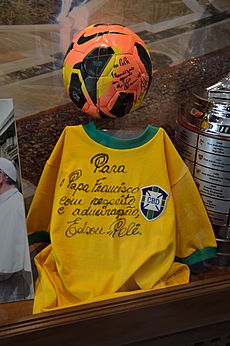
Pelé was married three times and had seven children.
On 21 February 1966, Pelé married Rosemeri dos Reis Cholbi. They had two daughters, Kelly Cristina and Jennifer, and one son, Edson ("Edinho"). They divorced in 1982.
In April 1994, Pelé married psychologist and gospel singer Assíria Lemos Seixas. They had twins, Joshua and Celeste, born on 28 September 1996. They divorced in 2008.
At 73, Pelé announced he would marry Marcia Aoki, who was 41. She was a Japanese-Brazilian importer of medical equipment. They had been dating since 2010 and first met in the mid-1980s. They married in July 2016.
Pelé and Politics
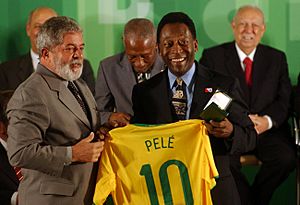
In 1970, the Brazilian government at the time, which was a military dictatorship, looked into Pelé. They thought he might have supported certain political ideas. Documents showed he was investigated after receiving a paper asking for political prisoners to be freed. Pelé himself did not get deeply involved in the country's political struggles.
In 1976, Pelé was in Lagos, Nigeria, for a Pepsi trip. An attempted military coup happened there. Pelé was stuck in a hotel with other sports stars. He and his group eventually moved to Brazil's ambassador's home because they couldn't leave the country for a few days. Later, Pelé left the country disguised as a pilot when the airport reopened.
In June 2013, some people criticized Pelé for his views during protests in Brazil. He asked people to "forget the demonstrations" and support the national football team.
Religion and Public Image
Pelé was a practicing Catholic. He gave a signed jersey to Pope Francis. This jersey, along with a signed football from Ronaldo, is now in one of the Vatican Museums.
Pelé was known for often talking about himself in the third person, saying things like "Pelé thinks..."
In Brazil, he is seen as a national hero. This is because of his football achievements and his support for helping poor people. When he became the first black global sports star at the 1958 World Cup, he inspired many.
Pelé's Death
Pelé passed away on 29 December 2022, at the age of 82, in Sao Paulo, Brazil. His agent, Joe Fraga, confirmed his death. Pelé had been receiving treatment for colon cancer since 2021. He had been in the hospital for a month before his death due to several health issues.
Pelé's Life After Football
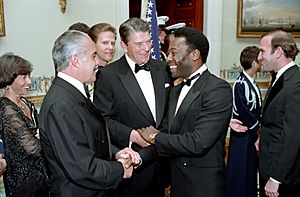
After retiring from football in 1977, Pelé received many awards for his playing and his records. He became a worldwide ambassador for football. He also took part in acting and commercials. In 2010, he was named the honorary president of the New York Cosmos.
In 1994, Pelé became a UNESCO Goodwill Ambassador. This means he helped promote peace and understanding around the world.
In 1995, the Brazilian President Fernando Henrique Cardoso made Pelé the Extraordinary Minister for Sport. In this role, Pelé suggested new laws to reduce corruption in Brazilian football. This became known as the "Pelé law." The position of Sports Minister was removed in 1998.
In 1997, Queen Elizabeth II gave him an honorary knighthood at Buckingham Palace. Pelé also helped open the 2006 FIFA World Cup finals.
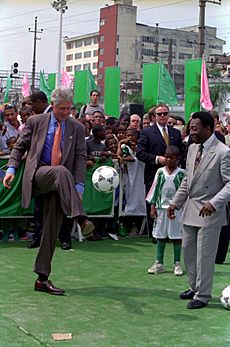
Pelé did a lot of ambassadorial work. In 1992, he became a UN ambassador for ecology and the environment. He also received Brazil's gold medal for his great service to sports in 1995.
In 2012, the University of Edinburgh gave Pelé an honorary degree. This was for his important work for humanitarian and environmental causes, as well as his sports achievements.
In 2009, Pelé helped Rio de Janeiro try to host the 2016 Summer Olympics. He spoke at a meeting in Nigeria to support Rio's bid.
On 12 August 2012, Pelé attended the 2012 Olympic hunger summit in London. This event was about fighting hunger around the world. Later that day, Pelé appeared at the 2012 Summer Olympics closing ceremony in London.
Besides his ambassador work, Pelé supported many charities. These included Action for Brazil's Children and SOS Children's Villages. In 2016, he sold over 1600 items from his collection, raising £3.6 million for charity. In 2018, Pelé started his own charity, the Pelé Foundation. It aims to help poor and disadvantaged children worldwide.
Pelé wrote several books about his life. He also appeared in documentary films and even composed music, including the soundtrack for the film Pelé in 1977.
Pelé in Films
He acted in the 1981 film Escape to Victory. This movie was about a football match during World War II between Allied prisoners of war and a German team. Pelé starred with other famous footballers and actors like Michael Caine and Sylvester Stallone.
In 1969, Pelé was in a TV show called Os Estranhos. It was about meeting aliens and was made to create interest in the Apollo missions.
He also had a small role in the 2001 film Mike Bassett: England Manager.
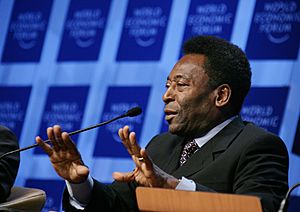

Pelé's Achievements and Awards
Pelé won many awards and titles throughout his career.
Team Trophies
- Santos
- Campeonato Brasileiro Série A: 1961, 1962, 1963, 1964, 1965, 1968
- Copa Libertadores: 1962, 1963
- Intercontinental Cup: 1962, 1963
- Campeonato Paulista: 1958, 1960, 1961, 1962, 1964, 1965, 1967, 1968, 1969, 1973
- New York Cosmos
- North American Soccer League, Soccer Bowl: 1977
- Brazil
- FIFA World Cup: 1958, 1962, 1970
Individual Awards
- FIFA Player of the Century: 2000 (shared with Diego Maradona)
- International Olympic Committee Athlete of the Century: 1999
- TIME: One of the 100 Most Important People of the 20th century: 1999
- World Soccer Greatest Player of the 20th Century: 1999
- BBC Sports Personality of the Year Lifetime Achievement Award: 2005
- FIFA Ballon d'Or Prix d'Honneur: 2013
- Ballon d'Or Dream Team: 2020
Records Held by Pelé
- Joint-most goals for Brazil national football team: 77 (tied with Neymar)
- Most goals for Santos: 643 goals in 659 competitive games
- Most goals scored in a single Campeonato Paulista season: 58 goals (1958)
- Most goals in a calendar year (recognized by FIFA): 127 goals (1959)
- Most hat-tricks in world football: 92
- Most career goals in world football (including friendly games): 1,283 goals in 1,363 games
- Most FIFA World Cup winners' medals: 3 (1958, 1962, 1970)
- Youngest winner of a FIFA World Cup: aged 17 years and 249 days (1958)
- Youngest goalscorer in a FIFA World Cup: aged 17 years and 239 days (vs Wales, 1958)
- Youngest player to score a hat-trick in a FIFA World Cup: aged 17 years and 244 days (vs France, 1958)
- Most assists provided in FIFA World Cup history: 10 (1958–1970)
Pelé's Career Statistics Summary
Pelé's goal statistics can vary depending on whether friendly games are included. RSSSF states he scored 775 goals in 840 official games. He holds the Guinness World Records for most career goals in football. In 2000, IFFHS named Pelé the "World's Best and successful Top Division Goal Scorer of all time" with 541 goals in 560 games.
Here is a summary of his official goals:
| Club/team | Matches | Goals |
|---|---|---|
| Santos FC | 660 | 643 |
| New York Cosmos | 64 | 37 |
| Brazil | 92 | 77 |
| Military Team | 4 | 4 |
| Selection São Paulo | 15 | 12 |
| Other Selections | 5 | 2 |
| TOTAL | 840 | 775 |
Filmography
| Year | Title | Role | Notes | Ref |
|---|---|---|---|---|
| 1969 | Os Estranhos | Plínio Pompeu | TV series | |
| 1971 | O Barão Otelo no Barato dos Bilhões | Dr. Arantes/Himself | ||
| 1972 | A Marcha | Chico Bondade | ||
| 1981 | Escape to Victory | Corporal Luis Fernandez | ||
| 1983 | A Minor Miracle | Himself | Also known as Young Giants | |
| 1985 | Pedro Mico | |||
| 1986 | Hotshot | Santos | ||
| 1986 | Os Trapalhões e o Rei do Futebol | Nascimento | ||
| 1989 | Solidão, Uma Linda História de Amor | |||
| 2001 | Mike Bassett: England Manager | Himself | ||
| 2016 | Pelé: Birth of a Legend | Man sitting in hotel lobby | Cameo appearance |
Images for kids
See also
 In Spanish: Pelé para niños
In Spanish: Pelé para niños


